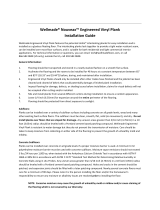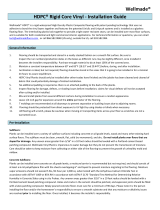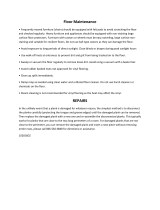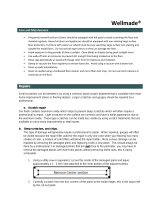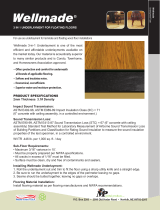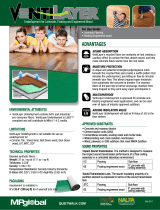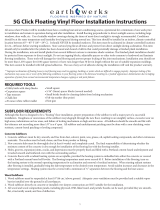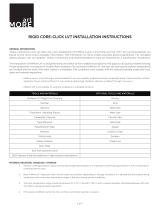Page is loading ...

Wellmade®
- Installation Guide
Wellmade WREW is a real wood veneer on a High Density Plastic Composite (HDPC™) flooring with patent pending
technology. WREW is a Water Resistant Engineered Wood plank flooring that bonds a wood veneer to our HDPC
backing to form one plank and features our Well-Loc™ click system and is installed as a glueless floating floor. The
interlocking planks lock together to provide a tight water resistant seam, can be installed over most floor surfaces,
and is suitable for both residential and light commercial interior applications. For technical information or
questions, you can email: tech@wellmadefloors.com , or call 866.582.0848 (US only); outside the US, call
503.582.0848.
General Information
1. Flooring should be transported and stored in a neatly stacked fashion on a smooth flat surface.
2. Flooring should be stored in the areas that it is going to be installed in for a minimal 24 hours to assist
with equilibrium of product and area.
3. Maintain a constant temperature between 60° and 85°F (18.33° and 29.44°C) before, during, and after
installation.
4. Wellmade WREW Planks should only be installed after other trades have finished and the jobsite has been
cleaned and cleared of debris that could potentially damage a finished plank installation.
5. Inspect flooring for damage, defects, or shading issues before installation; claims for visual defects will not
be accepted after cutting and/or installed.
6. Mix and install planks from several different cartons during installation to ensure a random appearance.
7. Leave 3/8 inch room for expansion around the entire perimeter of the flooring.
8. Flooring should be protected from direct exposure to sunlight.
9. Protect your flooring from scratches by following our maintenance procedures below.
Pre-Installation
Subfloors:
Planks can be installed over a variety of subfloor surfaces including concrete on all grade levels, wood and many
other existing hard surface floors. The subfloors must be clean, smooth, flat, solid (no movement), and dry. Do not
install planks over floors that are sloped for drainage. Any uneven areas greater than 3/16 inch (4.76mm) in a 10
foot (3.05m) radius should be leveled with a Portland cement based patching compound. Our Wellmade WREW
Plank is resistant to water damage but they do not prevent the transmission of moisture. Care should be taken to
keep moisture from collecting on either side of the flooring to prevent the growth of unhealthy mold and mildew.
Moisture Testing:
Sub-floor moisture testing is necessary, it will alert you of current moisture issues that may affect the installation
and promote the growth of unhealthy mold and mildew which could potentially affect you and your family’s health,
as well as the flooring. You may want to consult with a professional for proper testing and guidance. Moisture
levels above 12% in wood subfloors or 4.5 on moisture encounter meters for concrete subfloors can promote the
growth of mold and should be investigated to determine the cause and solution of the problem.
Checking for moisture: Use a Ligno DuoTec (or equivalent) moisture meter for wood, or a Tramex Concrete
Moisture Encounter meter (or equivalent) for concrete. You can also use a calcium chloride test for concrete; test
results above 3 lbs. per 1000 sq. ft., (or 75% RH using in-situ probes) in a 24 hour period can indicate a moisture
issue, and should be investigated.

Concrete Subfloors:
Planks can be installed over concrete on all grade levels if a proper moisture barrier is used. A minimum 6 mil
polyethylene moisture barrier should be used with concrete subfloors. Moisture vapor emissions should not
exceed 3 lbs./24 hour per 1,000 sq. when tested with the Anhydrous Calcium Chloride Test in accordance with
ASTM F 1869 or 75% RH in accordance with ASTM F 2170 “Standard Test Method for Determining Relative
Humidity in Concrete Slabs using in situ Probes. Any uneven areas greater than 3/16 inch (4.76mm) in a 10 foot
(3.05m) radius should be leveled with a Portland cement based patching compound. Holes and cracks in the
cement should be patched, and expansion joints should be filled with a latex patching compound. Newly poured
concrete floors must cure for a minimum of 90 days. Please note it is the person installing the floor and/or the
homeowner’s responsibility to ensure any moisture or alkalinity issues are resolved prior to installing the floor.
NOTE: Excessive moisture may cause the growth of unhealthy mold or mildew and/or cause staining of
the flooring which is not covered by our Warranty.
Wood Subfloors:
Planks should be installed over a smooth, flat, level wood subfloor, underlayment grade plywood, lauan plywood
and other underlayments recommended by the manufacturer for use with a floating plank floor. Subfloor should
be flat within 3/16 inch (4.76mm) in a 10 foot (3.05m) radius. Wood subfloors must be suspended at least 18"
above the ground. Adequate cross-ventilation must be provided, and the ground surface of the crawl space should
be covered with a suitable vapor barrier. If installing over a crawl space, a minimum 6 mil polyethylene moisture
barrier should be used.
NOTE: Avoid subfloors with excessive vertical movement or deflection because subfloor movement
may cause the locking mechanism to wear down, or even break. Indications of excessive deflection are
subfloor fastener release, squeaking, compromised or sectional contours such as bowing or dipping in
floors and uneven flooring material. Nail or screw subfloor panels to secure boards with excessive
vertical movement or deflection prior to installation of the flooring material. Our warranties DO NOT
cover any problems caused by inadequate substructures or improper installation of substructures.
Recommended Areas:
This flooring is suitable for installation in most areas of your home, including basements. This floor may not be
suitable for vacations homes or homes where the temperature is not controlled year-round. Care should be
taken not to expose the flooring to standing water or liquids for extended periods of time, as it may damage the
floor.
Existing Flooring:
Our Wellmade WREW Planks can be installed over a variety of finished floors including single layer resilient sheet
flooring/ tile, ceramic, marble and terrazzo. The surface must be in good condition and show no signs of excessive
moisture conditions. Grout joints and heavy embossing in tile or vinyl must be leveled so they are flush with the
flooring surface. Additionally the tile may require several skim coats to achieve a flat surface. Carpet, heavily
cushioned vinyl floors or vinyl floors consisting of multiple layers are NOT a suitable subfloor for installation.
Radiant Heat Subfloors:
Wellmade WREW Planks can be installed over in-floor radiant heating systems provided the subfloor surface does
not exceed 85°F (29.44°C) at any point. The initial floor temperature should not exceed 70°F (21.11°C) for 24 hours
prior, during, and 48 hours after installation. Thereafter the temperature should be gradually increased to the
desired setting up to 85°F (29.44°C). Because heat does affect both plastic and wood, you may need additional
room for expansion (larger expansion gap) and contraction (wider base to allow for contraction) Radiant heating
systems that are installed on top of the subfloor surface and not encased with self-leveling underlayment are not
recommended.

Important Notes:
Before removing any existing resilient flooring or tiles, please consult with a flooring professional to
determine if asbestos abatement is necessary to avoid exposure. See current edition of the Resilient
Floor Covering Institute (RFCI) publication “Recommended Work Practices for Removal of Resilient
Floor Coverings” for detailed information and instructions on removing all resilient covered structures.
Moisture Barrier and Underlayment Padding:
While it is not necessarily difficult to install a floating floor, you may want to consider having it done
by a professional installer. Bare concrete floors should have a moisture barrier of at least 6 mil polyethylene film
with the sheets overlapping 6” and taped to prevent moisture migrating to the flooring. If using a padding, use
1/8” foam padding (or other underlayment) over the moisture barrier as recommended by your dealer. You may
choose to use a 2 in 1 type underlayment (moisture & padding). You can also install over sound deadening
underlayment’s (3 in 1) with this method.
Pre-installation inspection:
It is the duty of the person installing the floor to inspect all flooring before installation. If during inspection the
installer or buyer feels the floors is the wrong color, improperly manufactured, is off-grade or is the wrong gloss
level, he/she should NOT install the flooring. Please immediately contact the retailer from which the flooring was
purchased. No claims will the accepted for flooring which is visibly wrong if such flooring is installed. Installed
flooring is deemed to be visibly acceptable.
General Tips
Remove wall base and undercut door jambs.
Do not secure individual planks to the subfloor as it is designed to be a floating floor.
Do not install cabinets on top of a floating floor.
It is recommended to separate all rooms using T molding, for separations in larger rooms call for
recommendations.
Installation
Pre-installation inspection:
It is the duty of the person installing the floor to inspect all flooring before installation. If during inspection the
installer or buyer feels the floors is the wrong color, improperly manufactured, is off-grade or is the wrong gloss
level, he/she should NOT install the flooring. Please immediately contact the retailer from which the flooring was
purchased. No claims will the accepted for flooring which is visibly wrong if such flooring is installed. Installed
flooring is deemed to be visibly acceptable.
1. First, determine how you want the flooring to run. Typically for plank products the flooring runs the
length of the room. There may be exceptions since it is all a matter of preference.
2. To avoid narrow plank widths or short plank lengths near the walls/doors, it is important to do some pre-
planning. Using the width of the room, calculate how many full boards will fit into the area and how
much space remains that will need to be covered by partial planks.
3. Start with a whole plank in the left hand corner of the room with the tongue side and end toward the wall.
Lay the first row of planks along a chalk line and trim to fit to the wall allowing a 3/8 inch (6.35mm)
expansion space. If starting the first row with a whole width plank it will be necessary to trim the tongues
next to the wall, then place the cut ends next to the wall. To trim the planks, a table saw works well for
both end and length cuts.
4. Align and attach the end joints of the planks in the first row using the fold down method, tap to lock the
joints securely. For length joints insert the tongue into the groove while holding the plank at a 20° to 30°
angle to the floor. Apply pressure inward and down until the planks lock together (Diagrams 1a & 1b). Use
spacers between the long edge and end of the planks next to the wall to maintain the expansion space.

Diagram 1a Diagram 1b
5. Start the second row using 1/3rd of a plank. Place the cut end against the wall. Insert the tongue on the
long side of the plank into the groove of the plank in the first row. Hold the plank in a 20° to 30° angle
while applying pressure inward and down until they lock together. To complete the second and all
successive rows, it will be necessary to align the short end onto the previous plank first before locking the
long side of the plank. Angle the plank and push the tongue into the groove and adjust it until the tongue
locks into place. It may be necessary to the planks inward to lock the joint together. Complete the second
row allowing 3/8 inch expansion space at the start and end of the row.
6. Start the third row using a 2/3rd length of a plank with the cut end against the wall. Complete each row
thereafter using a random layout with end joints off-set by at least 8”. Plan the layout to avoid using small
planks (less than 6”) at the walls and stagger the end joints 6 to 8 inches. The cut piece at the end of the
row can often be used to start the next row provided it achieves a random layout. Always place the cut
end against the wall and allow for the expansion space.
7. Wellmade WREW planks are unique in that they can also be installed using a tapping block and rubber
mallet or hammer and pull bar in difficult areas such as the last row and when fitting under door trim.
Always use a pull bar on the cut edge of the plank, factory edges can be damaged if the pull bar is used
directly against them.
8. When fitting around door trim it will be necessary to slide the plank under the trim. This can be
accomplished easily by starting the row on the side of the room with the door trim and then sliding the
plank into place once it is attached. The row can be completed by inserting the tongue onto the groove or
the groove under the tongue depending on the direction. A tapping block and pull bar (Diagrams 2a & 2b)
can also be used to lock the joints together while the planks are in a flat position. Use a series of light taps
until the joint is gradually locked together.
Diagram 2a Diagram 2b
Bathrooms: When Wellmade WREW planks are installed in a bathroom, remember that wood and water
do not get along and to avoid standing water if possible. The flooring should be installed around the toilet
leaving a 1/8 inch (3.175mm) expansion space. Use 100% silicone caulking to fill the expansion space at
the toilet, tub, shower, and all wet areas to help prevent surface water seepage from going under the
floor.

Pipes: In rows where there is a pipe or other vertical object through the subfloor, make sure the object
lines up exactly where two boards will meet on the short ends. Take care to measure carefully before
cutting, so the two boards end at the middle of the object. Use a drill or hole bit that is the diameter of
the pipe or object, plus 1/2 inch (12.7mm) for expansion/contraction. Lay the two short sides of the
boards together, then drill the hole centered on the joint between the boards as shown. Now you can
separate the two boards and install as normal. See Diagrams 6A – 6C.
Transitions, moldings, and wall base
T transitions are highly recommended in all doorways to allow each room to move independently. All
transition pieces should be attached to the subfloor, never attach transitions directly to the flooring.
Finishing The Job:
Inspect your work, as it will cost you more if you have to come back to do a repair later. Replace original
baseboards, or install matching hardwood baseboard. Install matching transitions as needed or recommended
by your dealer or installer. It is not recommended or necessary to seal this floor after installation. Protect your
floor from scratches by using felt pads on chair legs or furniture feet. Plastic rollers/castors can damage your
flooring; if necessary try to replace with softer rubber wheels/castors. When moving heavy items like
refrigerators, use at least two sheets of 1/4" Masonite or plywood while moving (sliding the appliance from
one sheet to the next) to protect the flooring against scratching and denting.
Congratulations!
You have just installed a beautiful, and elegant Wellmade Floor!
/


